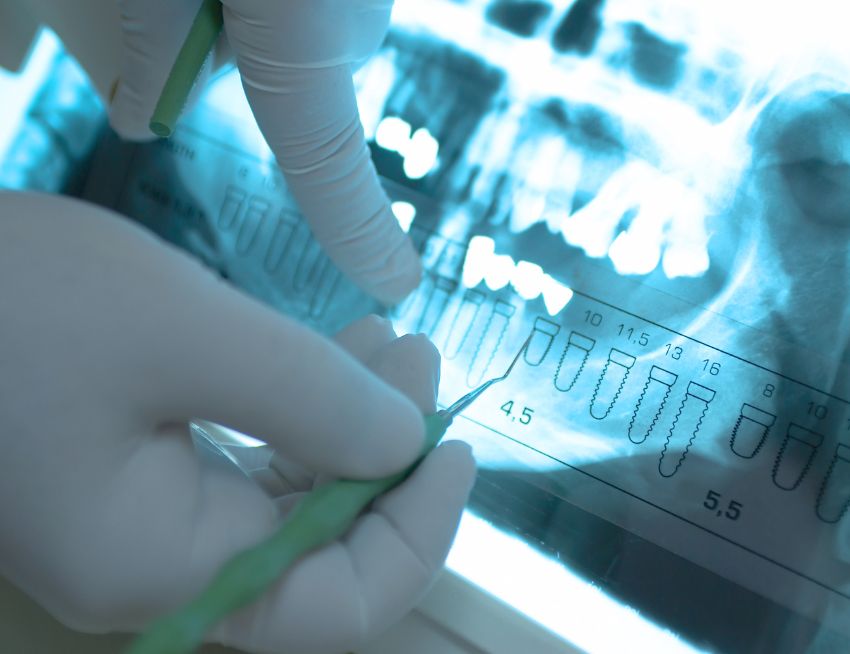Although dental implantation is considered a routine procedure, it is still a surgical procedure, so in order to get the optimal result and to recover as quickly as possible, we need to prepare for a few things in advance.
For our dentist to accurately determine the size and position of the dental implants, it is absolutely necessary to take a dental x-ray and/or CT scan of the area. With digital recordings, not only the quality of the bone stock, the location of the adjacent teeth and the sinus, but also the exact position of the nerves can be determined. As a result, we can prevent a lot of complications.
What happens before getting your dental implants?
Before getting your dental implant, the dentist assesses your oral cavity with a physical examination, followed by a 3D CT scan. It’s an accurate and precise imaging that you need for a safe and effective implantation procedure.
For the very first time, we take an X-ray while assessing your condition.
The panoramic X-ray is an integral part of the examination. With its help we can reveal structural changes that cannot be seen otherwise.
You will get an accurate dental diagnosis of the condition of your teeth.
What is a panoramic x-ray?
The panoramic x-ray is an established dental diagnostic tool.
It’s a two-dimensional imaging procedure that is part of the standard equipment in every dental office today. With a panoramic x-ray, you can get an accurate picture of the condition of the entire set of teeth and the entire oral cavity. The panoramic X-ray can reveal problems that are not visible to the naked eye. Your dentist will also see all the possible complications due to previous interventions.
How do X-rays work?
X-rays are electromagnetic radiation. During diagnostic tests, we generate a small amount of radiation that passes through the tissues to be examined.
Radiation easily passes through softer tissues, while harder tissues such as teeth and bone tissue absorb it.
The incoming rays from the tissues leave a mark on the film layer behind the examined body part or on a digital sensor, where we can obtain a black-and-white image. Soft tissues appear dark, hard tissues appear white. The explanation is simple: the more rays hit the film or sensor, the darker the image will be.
The panoramic x-ray examination is a quick procedure, including administration, it takes no more than 10 minutes.

When do you need a panoramic x-ray?
- when assessing the condition of your teeth
- during dental check-ups
- when examining root-treated teeth
- in cancer screening
- when placing dental implants
- when detecting larger, possibly hidden caries
- when examining periodontal disease
- to detect inflammation around the root tip
Is the panoramic X-ray safe?
The short answer is yes.
Although the body is exposed to radiation, it is negligible. Especially with patients also wearing a protective lead vest.
The procedure is quick and completely painless, though it is not recommended during pregnancy. If you expect a baby, consult your dentist.
The importance of 3D CT-scan for dental implants
The 3D CT works with an accuracy of a tenth of a millimetre and can display the patient’s oral cavity in three dimensions, rotating as desired. In this way, the implants can be planned based on size and angle, meaning that no one can be surprised during the operation.
With 3D CT, the thickness and height of the bone can be determined and measured without error, and all problems that are hidden even for the panoramic X-ray become visible.
After the 3D CT planning, the patient is informed about the expected progress of the implantation, and the treatment plan is drawn up.
Why dental x-rays are important before getting dental implants
As we have mentioned before, x-rays are important because they can show many problems regarding your teeth, jaw, and mouth that are often impossible to detect otherwise.
With the help of dental x-rays, your dentist can prepare for the dental implant surgery, and no surprises will come up during the procedure.
Remember, x-rays last only a few seconds, they are completely painless, and they use only a low level of radiation. Therefore, the dangers associated with dental x-rays are very low.

Types of x-rays
There are several types of x-rays. The two main types used for monitoring your dental implants are intraoral and extraoral x-rays.
Intraoral x-rays will help determine if there is any bone loss and the oral surgeon will be able to determine the health of the bone surrounding the dental implant. Intraoral x-rays are also important when it comes to monitoring the health of the patient’s jawbone.
Extraoral x-rays mainly focus on the teeth and jawbone. If there are any problems between the jaws and your teeth, with extraoral x-rays we can uncover them.
X-rays will identify dental implant failure
It’s very important to emphasize that dental implant failures are not common at all, however, some patients may experience it.
If there’s a serious bone loss around the implant, that might be an indicator of dental implant failure. With using dental x-rays, your surgeon will be able to determine this.
In case dental implant failure occurs, it may be replaced. If there’s a significant bone loss, you may need bone graft. If the bone around the implant is intact, there would be no need for a bone graft.
If you have been suffering from tooth loss and you think getting dental implants in Budapest are the best solution, request an appointment with our dental clinic in Hungary. Here you can get the best quality dental treatment in Europe while also saving on your costs.
Check out what others are saying about Budapest Top Dental: Read our reviews.


